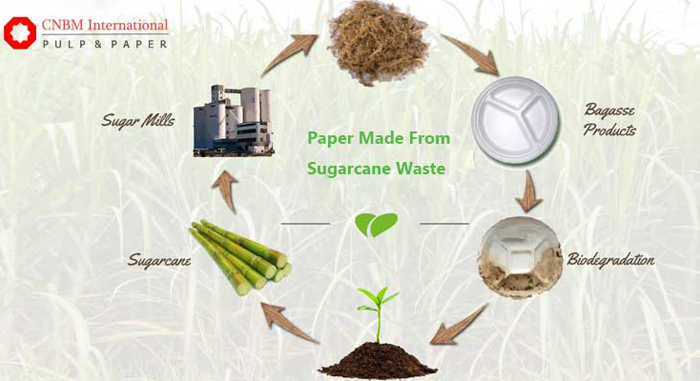How to make pulp with bagasse
The structure of bagasse is complex, but its main components are cellulose, hemicellulose and lignin. Among them, hemicellulose is about 20.6% and lignin is 18.6%. The content of cellulose in bagasse is about 35.4%, which is composed of β-1,4-glycosidic bond, and is a two-phase coexisting system (the crystallization zone and the amorphous zone coexist). The crystallization zone contains a hydroxyl group which readily forms a hydrogen bond with the surface molecules, and the crystalline portion using cellulose is difficult to be decomposed. Bancell cellulose is chemically similar to cellulose, and its degree of polymerization is relatively small. The hemicellulose of bagasse contains about 70% cellulose and 30% polyarabinose.
The main component of paper is plant fiber. Bagasse is rich in hemicellulose, cellulose, lignin, etc. It is an excellent raw material for papermaking. However, if the bagasse is directly mechanically pulped, because of the influence of lignin, the energy consumption of the refining is too large, and the cost of pulping is high, so it is necessary to try to eliminate the lignin.
Sugarcane is a kind of grass fiber, easy to boil and easy to float, and consumes less chemicals. Although the silicon content is higher than that of wood, it is lower than other grass fiber raw materials. Therefore, the bagasse pulping and alkali recovery process technology and equipment are mature and simpler than other grass fiber materials. The bagasse bleaching chemical pulp can be used to make various high-grade cultural and household papers after blending a certain amount of long fibers.

Bagasse papermaking technology and main equipment
- Preparation: First, the first semi-drying of the marrow in the sugar factory, and then packaged and sent to the paper mill for dry storage, and then used the horizontal or vertical degumming machine to dry the marrow and get a drink. Papermaking raw materials.
- Pulping: The pulping process is: cooking → washing → screening → bleaching. The most common cooking equipment for bagasse is steamer. Because bagasse is relatively easy to cook, it is more suitable for small-scale enterprises to use cooking pots as cooking equipment because of its low investment, simple operation and high flexibility. The most commonly used equipment for washing equipment is the drum vacuum washer. Because of its low operating cost, simple operation and high black liquor extraction rate, many manufacturers use this equipment as a washing equipment.
- The traditional screening system is an open low-concentration screening system with a screening concentration of 0.8-1.0%. The CX sieve and low-concentration desander are used. The water consumption per ton of pulp is up to 100m3, and the sewage is discharged 75m3, which directly increases the manufacturing cost of the product.
- Sugarcane slurry is easier to bleach. Ordinary CEH three-stage bleaching can bleach bagasse pulp to 80% ISO, so the old sugarcane pulp production line basically uses CEH three-stage bleaching.
- Alkali recovery: The conventional alkali recovery system is an evaporation, combustion, causticizing process for treating black liquor and recovering chemicals and heat. Short-tube four-effect evaporation station, jet combustion furnace, continuous causticization, clarifier clarification white liquor, vacuum slag washing machine and other traditional bagasse pulping alkali recovery technology and equipment are relatively mature and run better.

